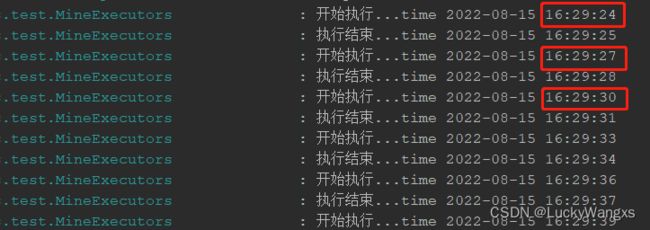ScheduledExecutorService详解
ScheduledExecutorService有线程池的特性,也可以实现任务循环执行,可以看作是一个简单地定时任务组件,因为有线程池特性,所以任务之间可以多线程并发执行,互不影响,当任务来的时候,才会真正创建线程去执行
我们在做一些普通定时循环任务时可以用它,比如定时刷新字典常量,只需要不断重复执行即可,这篇文章讲解一下它的用法以及注意事项,不涉及底层原理
注意:我们都知道,在使用线程池的时候,如果我们的任务出现异常没有捕获,那么线程会销毁被回收,不会影响其他任务继续提交并执行,但是在这里,如果你的任务出现异常没有捕获,会导致后续的任务不再执行,所以一定要try...catch
1. 延迟不循环任务schedule方法
schedule(Runnable command, long delay, TimeUnit unit)
参数1:任务
参数2:方法第一次执行的延迟时间
参数3:延迟单位
说明:延迟任务,只执行一次(不会再次执行),参数2为延迟时间
案例说明:
@Component
@Slf4j
public class MineExecutors {
private final static ScheduledExecutorService scheduler = Executors.newScheduledThreadPool(5);
private final static SimpleDateFormat format = new SimpleDateFormat("yyyy-MM-dd HH:mm:sss");
@PostConstruct
public void init() {
scheduler.schedule(() -> {
try {
log.info("开始执行...time {}", format.format(new Date()));
Thread.sleep(1000);
log.info("执行结束...time {}", format.format(new Date()));
} catch (Exception e) {
log.error("定时任务执行出错");
}
}, 5, TimeUnit.SECONDS);
log.info("初始化成功 {}", format.format(new Date()));
}
}
可以看到任务执行时间为初始化完成后5s才开始执行,且只执行一次

2. 延迟且循环cheduleAtFixedRate方法
cheduleAtFixedRate(Runnable command, long initialDelay, long period, TimeUnit unit)
参数1:任务
参数2:初始化完成后延迟多长时间执行第一次任务
参数3:任务时间间隔
参数4:单位
方法解释:是以上一个任务开始的时间计时,比如period为5,那5秒后,检测上一个任务是否执行完毕,如果上一个任务执行完毕,则当前任务立即执行,如果上一个任务没有执行完毕,则需要等上一个任务执行完毕后立即执行,如果你的任务执行时间超过5秒,那么任务时间间隔参数将无效,任务会不停地循环执行,由此可得出该方法不能严格保证任务按一定时间间隔执行
错误:任务连续执行案例:
@Component
@Slf4j
public class MineExecutors {
private final static ScheduledExecutorService scheduler = Executors.newScheduledThreadPool(5);
private final static SimpleDateFormat format = new SimpleDateFormat("yyyy-MM-dd HH:mm:ss");
@PostConstruct
public void init() {
scheduler.scheduleAtFixedRate(() -> {
try {
log.info("开始执行...time {}", format.format(new Date()));
Thread.sleep(3000);
log.info("执行结束...time {}", format.format(new Date()));
} catch (Exception e) {
log.error("定时任务执行出错");
}
}, 0, 2, TimeUnit.SECONDS);
log.info("初始化成功 {}", format.format(new Date()));
}
}
由上面代码可以看出,任务执行需要3秒,而我们设定的任务时间间隔为2秒,如此就会导致任务连续执行,该方法不能严格保证任务按照规定的时间间隔执行,如果你的任务执行时间可以保证忽略不计,则可以使用该方法,我们可以看到下面日志,上一个任务的执行结束时间与下一个任务的开始时间一致,所以任务连续循环执行了

正确案例:
@Component
@Slf4j
public class MineExecutors {
private final static ScheduledExecutorService scheduler = Executors.newScheduledThreadPool(5);
private final static SimpleDateFormat format = new SimpleDateFormat("yyyy-MM-dd HH:mm:ss");
@PostConstruct
public void init() {
scheduler.scheduleAtFixedRate(() -> {
try {
log.info("开始执行...time {}", format.format(new Date()));
Thread.sleep(1000);
log.info("执行结束...time {}", format.format(new Date()));
} catch (Exception e) {
log.error("定时任务执行出错");
}
}, 0, 3, TimeUnit.SECONDS);
log.info("初始化成功 {}", format.format(new Date()));
}
}
3. 严格按照一定时间间隔执行``
scheduleWithFixedDelay(Runnable command, long initialDelay, long delay, TimeUnit unit);
参数1:任务
参数2:初始化完成后延迟多长时间执行第一次任务
参数3:任务执行时间间隔
参数4:单位
解释:以上一次任务执行结束时间为准,加上任务时间间隔作为下一次任务开始时间,由此可以得出,任务可以严格按照时间间隔执行
案例:
@Component
@Slf4j
public class MineExecutors {
private final static ScheduledExecutorService scheduler = Executors.newScheduledThreadPool(5);
private final static SimpleDateFormat format = new SimpleDateFormat("yyyy-MM-dd HH:mm:ss");
@PostConstruct
public void init() {
scheduler.scheduleWithFixedDelay(() -> {
try {
log.info("开始执行...time {}", format.format(new Date()));
Thread.sleep(5000);
log.info("执行结束...time {}", format.format(new Date()));
} catch (Exception e) {
log.error("定时任务执行出错");
}
}, 0, 3, TimeUnit.SECONDS);
log.info("初始化成功 {}", format.format(new Date()));
}
}
由下图日志可以看出,下次任务的开始时间是在上一次任务结束时间+任务时间间隔为准的,严格按照任务时间间隔,规律执行,如果你的任务需要保证严格的时间间隔,可以用该方法启动任务

其他用法与线程池没有差异了,例如ThreadFactory作为参数传入,自定义线程池内线程名称之类的,不多解释了。
能力有限,不足之处,欢迎指正~
